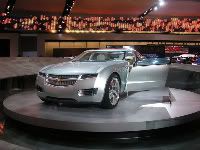Extended Range Electric Vehicles and Plug-in Hybrids
Frequent commenter MarcoPolo writes:
Craig, EREVs (extended range electric vehicles), are not simply ‘Plug-in hybrids’. The GM Volt is an astonishing example of US engineering, and advanced technology. All Americans should feel proud of the GM Volt.
I have to admit that it’s a cool idea, and I’m glad that GM appears to be onboard with a migration, albeit a slow one, away from oil. But I do believe that the EREV (as they call it) will be a short-lived concept that will have little bearing on the future of transportation.
Btw, the difference between the terms “extended range electric vehicle” (EREV) and “plug-in hybrid” is semantics. In fact, I recall thinking when I saw that GM had coined the phrase EREV in an attempt to differentiate the Volt from the other plug-in hybrids, “Now that’s marketing at its finest.” All such vehicles have batteries that provide a given range, and internal combustion engines (ICEs) that extend that range. Yes, there are variations on the theme as to what precisely the ICE does (charge the battery? power the car? both?) But we’re really talking about a single concept.


Craig, not really semantics.
All EV technology is evolving, and new descriptions will be developed to describe different types of vehicles.
However, the Volt, like the Prius/Lexus hybrids before it, is an important step in producing a practical vehicle employing EV technology. Hybrids were once unique oddball vehicles, not every manufacturer is producing a hybrid, even Ferrari!
Ev’s are an evolutionary process.
The difference between an EREV like the Volt an da hybrid like the Prius is substantial, not just marketing goop. It’s an evolutionary step, and it’s embodied in the name. It is, indeed, “extended range,” and it is primarily an “electric vehicle,” as opposed to the Prius, which is a gas-engine car augmented with an electric motor. Think of the difference as a matter of emphasis: electric-gas, not gas-electric. And given the Volt’s very high gas-equivalent mileage, this engineering solution will be around for a while, at least until we figure out how to make batteries that can give a vehicle 250 miles, recharge quickly, and can be recharged many many times before they are safely recycled — in other words, until quantum mechanics migrates to the machine shop and the cows come home.
I wasn’t referring to hybrids, but to plug-in hybrids.
The difference between a range extended electric, such as the Chevy Volt, and a plug in hybrid are substantial.
A plug in hybrid is the same technology as a non plug in hybrid. The engine, generator, and traction motor are all connected to a planatary gear set. At lower speeds the plug in hybrid can run in electric mode untill the battery is discharged, but at higher freeway speeds, the gas engine must always start. This is becsause in electric mode, the generator is freewheeling, and at freeway speeds the generator would be spinning too fast, so the gas engine needs to start, so that, by means of the CVT the speed can be lowered for the generator.
The volt also uses a planatary geat set, but the configuration is totally different. There are also 3 clutches that can configure the planatary gear set as a single motor electric, dual motor electric for full electric operation. Once the battery is depleted, the clutches switch back to single motor operation mode, and the second motor is connected to the gas engine and functions as a generator. In this mode the car operates as a series hybrid. There is a 4th mode of operation reserved for specific battery charge level conditions that can connect the engine to the power split, and take some power from the engine and pass it into the CVT.
The big thing is extended range operate at all speeds in full electric mode. Plug in hybrids operate in non freeway speeds in electric mode, but once you get to freeway speeds the gas engine needs to start. I own both a volt, and plug in prius. No comparision. The volt runs circles around the prius. I put more miles on the volt than my wife does on the prius, and she has to regularly put gas in her’s. I have filled up 2 times since last year.
“I have filled up 2 times since last year.”
I read that after gas sits for a month the Volt burns it so it doesn’t sit. Does that mean it will function as a true EV and never bother you about being empty of gas? As in pop-ups stating you’re empty, or ceasing to function unless filled with some gas?
I own a LEAF and was wondering about a Volt for my wife.